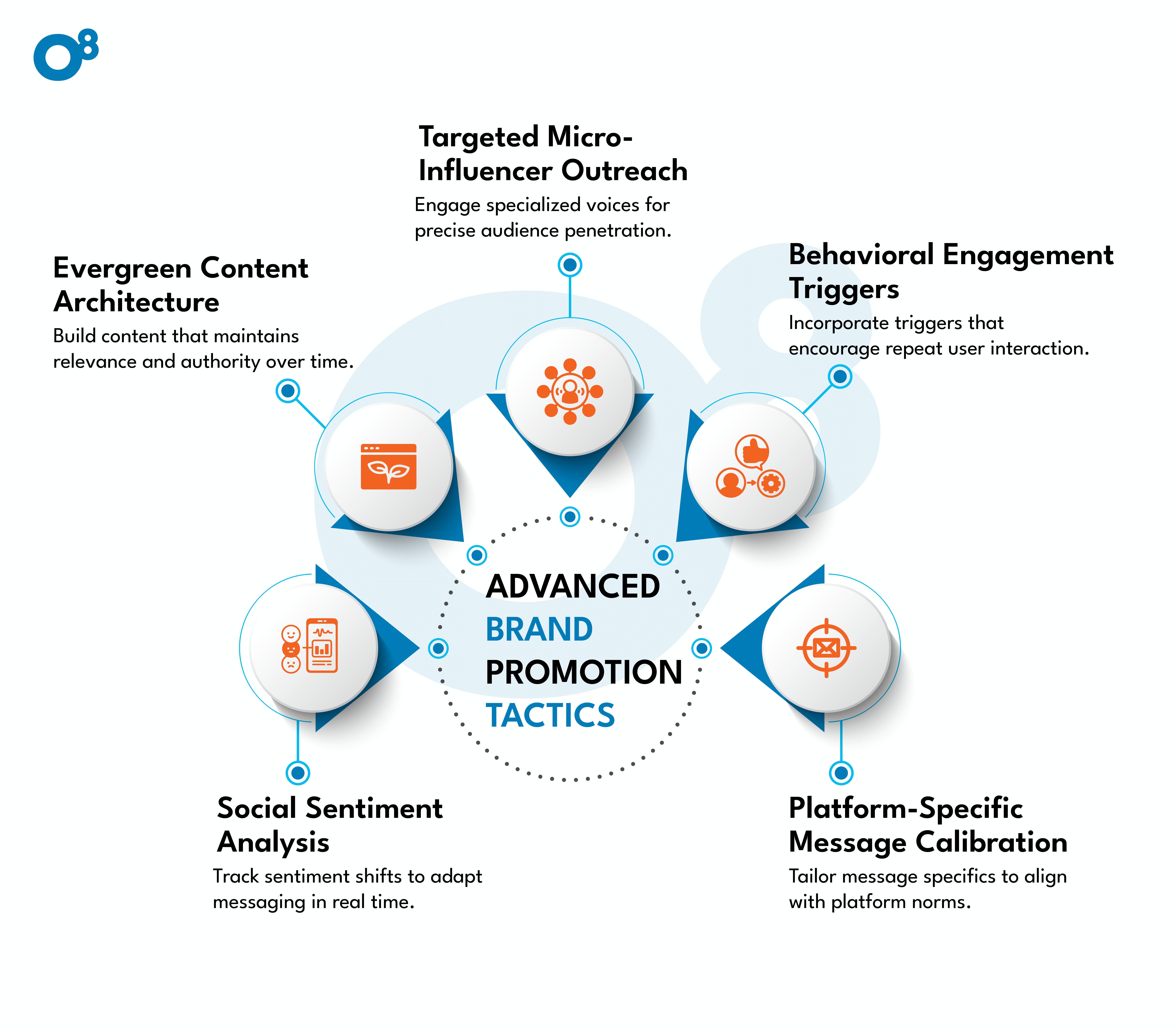Branding vs. Marketing: Unlock the Secrets to Business Growth

- Branding defines your company’s identity, positioning, and values, while marketing communicates it to attract the right customers.
- Most people buy from brands they follow on social media, trust, and align with on a values level.
- To reach your ideal buyer, maintain a consistent brand experience across all channels.
- An impactful marketing strategy that drives growth starts by clarifying brand values, aligning marketing with sales, using the right analytical tools, and adapting to feedback.
With audiences prioritizing connection over promotion, branding in marketing helps businesses build relationships by giving their products and services an identity, personality, and values that resonate.
Yet, branding and marketing are often treated as isolated silos or interchangeable concepts. The reality? Branding defines who you are and what you stand for, while marketing turns that identity into visibility and engagement. Without a strong brand, marketing lacks direction. Without effective marketing, even the best brand goes unnoticed.
A consistent brand presentation can boost revenue by up to 23%, proving that when branding and marketing align, they create deeper connections and drive growth.
In this article, we’ll break down branding vs. marketing, why alignment matters, and how to integrate them for lasting impact. You’ll learn key strategies, brand promotion techniques, and how to adapt to market trends.
The Core Elements of Branding

Over half of a brand's first impressions are visual, and something as simple as logo color can boost brand recognition by up to 80%. But building a strong brand goes far beyond visual identity.
Surveys consistently show that people buy from brands they not only recognize but also trust, follow, and align with on a values level. In fact, 82% of customers purchase from brands they feel emotionally connected to.
This connection isn’t built by visuals alone—it comes from a brand’s deeper identity and the meaning it conveys.
At its core, brand identity includes elements like definition, essence, positioning, equity, and personality. Together, these components create a distinct and memorable image in the minds of consumers.
For example, brand positioning defines where your brand stands in the market relative to competitors, while brand equity reflects the added value your brand brings to products or services, directly impacting customer choices and loyalty.
Without a doubt, brand identity isn’t just a nice-to-have element; it’s foundational to your overall strategy. It shapes how customers perceive your business and plays a pivotal role in guiding your marketing efforts.
When you have a well-defined identity it becomes easier to streamline tone and messaging across all channels. With that foundation in place, let’s explore how to effectively leverage your brand identity in your marketing strategy.
Spotting the Differences: Brand and Marketing in Action

Understanding the distinct roles of branding and marketing is crucial for driving business success.
While branding establishes your company’s identity—the character, promise, and emotional connection—it’s marketing that actively communicates this identity to the world and attracts the right customers.
Branding: The Emotional Connection
In more practical terms, branding creates an emotional connection with your audience. Think of it as the reputation and story you carry.
For example, brands like Nike or Apple are more than just products; they represent a community, innovation, and lifestyle. Here's where the emotional pull makes a significant difference:
- Trust: Branding builds trust with your audience, encouraging loyalty and repeat business.
- Identity: It clearly defines what your business stands for, helping consumers relate to your values.
- Loyalty: A strong brand fosters customer loyalty, turning buyers into advocates.
Marketing: The Activation Engine
Now, marketing takes these branding efforts and communicates them to the world. It's about reaching the right people and delivering messages that resonate.
Consider marketing as the engine that runs your brand's message, using tools like:
- Social Media Campaigns: Engage audiences on platforms where they already spend time.
- Content Marketing: Share stories or useful insights that align with your brand's identity.
- Promotions: Execute targeted promotions to highlight brand strengths and drive sales.
The Power of Integration
While branding builds the foundation, marketing propels it forward—both working together to enhance visibility and trust. But there’s one more key piece of the puzzle: integrating these efforts into cohesive campaigns across multiple channels.
Effective alignment between branding, marketing, and sales creates a seamless customer experience, leading to stronger results.
According to HubSpot, when these elements come together, companies see a 208% increase in revenue and improved retention, ensuring that every touchpoint reinforces a unified message that drives long-term loyalty.
Align Your Brand with Strategic Marketing
At O8, we fuse top-tier branding and marketing expertise to ensure every message connects, engages, and drives results.
Building Integrated Marketing Strategies

While 85% of organizations have brand guidelines, only 30% consistently enforce them, leading to inconsistent messaging and a weakened brand presence.
Off-brand content doesn’t just affect aesthetics—it impacts brand trust and conversion rates. Many marketers focus on visuals but neglect the messaging and strategy that truly drive engagement.
Here's how you can build integrated marketing strategies for stronger impact:
- Clarify Your Brand Values: Start by clearly defining your brand’s core values and ensure they guide all marketing decisions.
- Leverage Multiple Channels in Harmony: Utilize various digital marketing platforms like social media, newsletters, and traditional advertising to broadcast your message. Each platform serves a unique purpose, but all should consistently reflect your brand's identity.
- Synchronize Marketing and Sales: Marketing and sales must work hand-in-hand to ensure messaging stays aligned from awareness to conversion.
- Employ the Right Tools for Seamless Execution: Use analytics tools, CRM systems, and automation to measure performance and align your marketing efforts with your brand’s core values.
- Adapt and Respond to Feedback: Regularly gather insights from your audience and use that feedback to adjust your marketing approach.
By integrating these elements, you create a cohesive marketing strategy that ensures your brand is always represented consistently, regardless of the channel. This results in stronger customer connections, more impactful engagement, and ultimately, sustainable growth.
Effective Brand Promotion Techniques
Promoting your brand today means more than just gaining visibility—it’s about understanding what matters to your audience. To build real connections, you need to know who they are, what motivates them, and where they spend their time.
Here’s how to apply this approach:
- Social Media Engagement: Use platforms like Instagram, LinkedIn, and Twitter to share stories that reflect your audience's values. Go beyond updates—post behind-the-scenes content, customer stories, and interactive posts that foster connection and engagement.
- Content Marketing: Craft a content strategy that delivers value to your audience. Blog posts, videos, and infographics can showcase your expertise and enhance brand awareness. Content marketing is not just about selling but providing value that keeps your audience coming back.
- Collaborations and Partnerships: Partner with influencers or complementary brands to reach new audiences. This strategy can introduce your brand to potential customers who may not have discovered you otherwise.
- Interactive Campaigns: Develop campaigns that invite audience participation, such as polls, contests, or interactive videos. These can increase engagement and make your brand more memorable.

Navigating Brand and Market Dynamics
To stay competitive, brands must evolve with industry trends and shifting consumer behavior. Regular brand market analysis helps identify strengths, weaknesses, and areas for improvement.
A thorough brand market analysis is essential to understanding your position in the marketplace compared to your competitors. It reveals your strengths and weaknesses, guiding strategic decisions and informing marketing efforts.
For instance, Avrio Solutions partnered with O8 to strengthen their brand as they expanded into new markets. With a changing market and a broader target audience, they needed consistent branding to position themselves effectively. Our team's expertise in branding and digital marketing enabled them to refine their identity and align it with their evolving business goals.
Staying flexible with brand positioning is crucial to keep up with market trends and consumer expectations. Adjusting your messaging to highlight values that resonate with consumers strengthens your brand’s presence. Engaging with your audience through feedback and social media interactions helps refine your strategy, build loyalty, and stay relevant.
Brand Marketing vs. Corporate Marketing: Understanding the Distinction
Let's explore the subtle difference between brand marketing and corporate marketing: their focus.
Corporate marketing, also called B2B marketing, promotes a business’s image and positions it within the market, targeting other businesses and fostering partnerships.
Brand marketing, however, is about building an emotional connection with consumers. It's not just about getting noticed or finding a unique space in the market—it’s about resonating with people and earning their trust. It shapes your brand’s personality, ensuring that every interaction reflects the values and promises your brand stands for. This consistency builds loyalty and trust over time.
Brand marketing directly impacts corporate identity and sales. A strong brand boosts credibility and market respect. For example, Ryan Companies partnered with O8 to develop a custom brand style guide, clarifying their identity and supporting their expansion into new markets.
Overall, a well-executed brand campaign increases visibility, reinforces values, and amplifies corporate marketing by creating a relatable identity that drives customer loyalty.
The Role of Branding in Marketing
Branding is the foundation of your marketing strategy, providing a cohesive identity across all touchpoints. It clarifies your company’s mission, values, and unique qualities, simplifying long-term marketing efforts. A strong brand enables campaigns with a consistent narrative—hero, conflict, and solution—making your message clearer to your audience.
Once your brand’s core elements are established, integrating them into various marketing campaigns becomes seamless. This includes creating a cohesive visual and verbal identity that resonates with your audience. For example, MedSource Labs partnered with O8 to rebrand and successfully transition to an e-commerce platform, strengthening their market position and reinforcing their brand identity.
Branding is essential for reaching your audience effectively. Without it, your marketing may lack direction, and your message could miss the mark. SEO ensures your brand’s message is visible to the right people. While branding defines your identity, SEO makes sure your message is seen by those actively seeking solutions like yours. Without strong SEO, even the best brand can remain hidden in a crowded market.
That being said, visual branding acts as the packaging, while SEO is the distribution channel. To truly succeed, marketers must balance both to make sure their brand stands out and reaches the right audience at the right time.
Integrating Marketing and Branding for Synergy: Holistic Marketing
Now that we've outlined the key distinctions between marketing and branding, it’s time to dive into the tactical steps for integrating them effectively. Here’s how to create a seamless strategy that amplifies both efforts through a holistic marketing approach:
- Sync Your Messaging Across Channels
Ensure your brand’s voice, tone, and visuals align in every marketing channel—from your website and email campaigns to social media posts and paid ads. Holistic marketing thrives on this consistency, building trust and recognition at every customer touchpoint. - Use Data to Inform Brand-Driven Marketing
Leverage analytics to understand what resonates with your audience. Apply these insights to fine-tune both branding and marketing efforts. For example, use engagement metrics to see which brand messages drive the most conversions, ensuring your strategy remains responsive and integrated. - Align Marketing Campaigns with Brand Goals
Every marketing campaign should support broader brand objectives. Whether launching a new product or running a seasonal promotion, ensure it reinforces your brand’s values and identity. This alignment helps create a cohesive brand experience that strengthens customer relationships. - Foster Collaboration Between Teams
Break down silos between branding, marketing, and sales teams. Regular cross-functional meetings ensure alignment on goals, messaging, and campaign execution. A holistic marketing approach thrives on this synergy, ensuring that everyone works toward a unified vision. - Utilize Automation Tools for Consistency
Marketing automation platforms like HubSpot help maintain consistent messaging while scaling efforts. Automate repetitive tasks while ensuring your brand voice stays intact, allowing your team to focus on strategic growth initiatives. - Embrace Continuous Feedback and Adaptation
Branding and marketing integration isn’t a one-time task—it requires ongoing adjustment. Use customer feedback, performance data, and market shifts to refine your approach continually. This continuous loop of feedback and improvement is key to holistic marketing success.
By embedding these practices into your strategy, you’ll create a unified brand presence that’s both agile and impactful. Holistic marketing not only drives long-term growth but also deepens audience connections by ensuring every interaction reflects your brand’s core identity and values.
Building Brand Campaigns that Resonate

A whopping 89% of marketers prioritize brand awareness over sales and lead generation, demonstrating the immense value placed on making a brand memorable.
Today, successful campaigns go beyond brand storytelling—they integrate data-driven growth and performance marketing strategies to boost visibility, engagement, conversions, and loyalty.
Brands like Apple have mastered this balance. By focusing on innovation and simplicity, their campaigns leave lasting impressions while reinforcing their leadership in technology and design.
To create your next winning branding campaign, consider these 6 essential elements:
1. Align Campaigns with Brand Goals
Define how each campaign supports your objectives, from building awareness to driving user acquisition.
2. Blend Creativity with Data
Let analytics guide your storytelling. Refine messages based on what resonates with your audience.
3. Apply Growth Marketing Tactics
Run rapid experiments. A/B test messaging, formats, and channels to optimize engagement and conversions.
4. Leverage Performance Marketing
Deploy targeted ads and track metrics like CPC, CAC, and LTV to ensure measurable ROI.
5. Measure Beyond Engagement
Monitor brand mentions, sentiment, and conversions to assess both short-term wins and long-term brand equity.
6. Innovate with New Formats
Explore interactive content, influencer partnerships, and AI-driven personalization to keep your campaigns fresh.
Branding campaigns are not just about reaching your audience; they’re about creating lasting connections. By integrating these six elements into your next campaign, you can ensure your brand stays relevant, resonates deeply, and drives measurable growth.
Branding vs Marketing: Understanding Their Unique Roles
Let’s explore how branding and marketing interact to deliver both immediate results and long-term value, driving business growth.
Branding Shapes Perception, Marketing Drives Action
Branding defines the "who" and "why" of your business, influencing consumer perceptions and emotional connections. Marketing is the tactical execution that moves people to take action—whether it’s purchasing, signing up, or engaging.
A Strong and Consistent Brand Foundation
A consistent brand builds trust and recognition, enhancing marketing efficiency and reducing customer acquisition costs over time.
Strategic Differences: Long-Term Equity vs. Short-Term Results
Branding builds long-term equity and loyalty, while marketing focuses on short-term goals like lead generation and conversions. Integrating both ensures sustainable growth.
Branding’s Influence on Consumer Behavior
Branding taps into emotions and values, influencing purchase decisions beyond features or price. It fosters higher customer retention and advocacy by resonating with customers' identities and lifestyles.
Wrapping It All Up: Branding and Marketing Together
As we've explored, branding and marketing each play unique yet complementary roles in driving business success. Branding is the blueprint of your company's identity, laying the foundation for all interactions with your audience. It builds the trust and loyalty that spur long-term relationships. Conversely, marketing is about executing strategies to convey your brand's identity, ensuring that your message reaches and resonates with the right people.
Branding in marketing contributes significantly to business growth. While branding focuses on creating emotional connections and lasting impressions, marketing delivers those messages effectively across various platforms. This dual approach is crucial for navigating today’s competitive market, where businesses must both stand out and connect deeply with their audience.
At O8, we specialize in making this integration seamless. As a full-service marketing agency, we don’t treat branding as just "arts and crafts." We develop brand strategies that directly contribute to business growth, aligning them with data-driven marketing campaigns that deliver measurable results. Our holistic marketing services, combined with a proven track record in branding, ensure that your business not only looks good but performs exceptionally in the market.
In conclusion, understanding the distinction and interplay between branding and marketing can elevate your business strategy. By leveraging the strengths of both—and partnering with experts like O8—companies can foster a powerful market presence, build enduring customer relationships, and achieve long-term growth.
Ready to elevate your brand and drive measurable growth?
Discover how a tailored strategy can transform your business.








